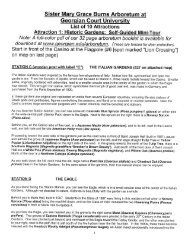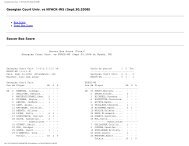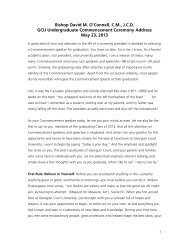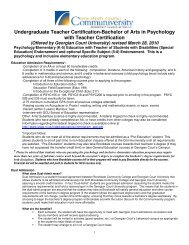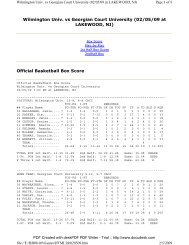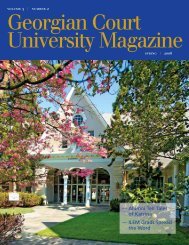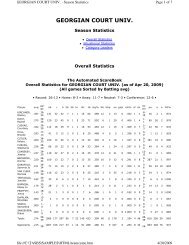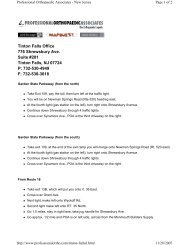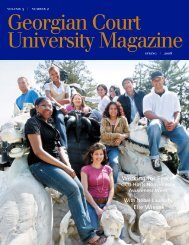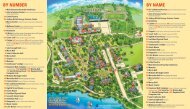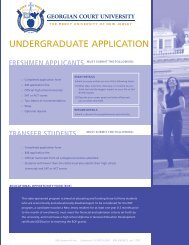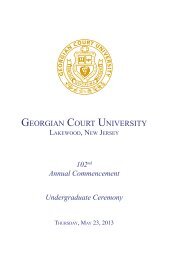Georgian Court University Magazine
Georgian Court University Magazine
Georgian Court University Magazine
You also want an ePaper? Increase the reach of your titles
YUMPU automatically turns print PDFs into web optimized ePapers that Google loves.
Invasive Species Conference a Success<br />
Dr. Wootton leads a preconference discussion<br />
at Sandy Hook, one of New Jersey’s<br />
few remaining natural barrier islands.<br />
While plenty of people flock<br />
to the shore for fun, it’s also<br />
where scientists get down<br />
to business. And for <strong>Georgian</strong> <strong>Court</strong><br />
<strong>University</strong> biology professor Louise<br />
Wootton, Ph.D., that would be the<br />
business of determining what types of<br />
plants belong near the beach, and what<br />
needs to go—namely, Carex kobomugi.<br />
The problematic plant, also known<br />
as Asiatic sand sedge, was among the<br />
many topics discussed when GCU hosted<br />
the July 16–17 conference on Invasive<br />
Species in Coastal Dunes and Maritime<br />
Forests. The event, co-sponsored by<br />
GCU, the New Jersey Marine Sciences<br />
Consortium/NJ Sea Grant and the<br />
Cape May Plant Materials Center, drew<br />
ecologists, marine scientists, educators,<br />
and environmental managers from<br />
Maine to South Carolina.<br />
“Scientists don’t always have the<br />
luxury of being in one place all at once,”<br />
says Dr. Wootton, whose research has<br />
examined how the sedge negatively<br />
affects habitats, other plants, and animal<br />
life. Attendees at the meeting shared<br />
difficult experiences with beach vitex—a<br />
woody plant that crowds out native<br />
species and destroys the nesting habitat<br />
of sea turtles—as well as Japanese<br />
honeysuckle, English ivy and, of course,<br />
Asiatic sand sedge.<br />
But no matter what invasive species<br />
is at issue, swift action is critical.<br />
“If you attack it early, you’re looking<br />
at saving money through early detection<br />
and rapid response,” says Dr.Wootton.<br />
“You save the ecosystem and money by<br />
fixing it before the damage is done.”<br />
Spotting the Species<br />
A few weeks after the conference,<br />
attendee Jonathan Chase, a biological<br />
science technician at Maryland’s<br />
Assateague Island National Seashore,<br />
was out looking for the threatened<br />
seabeach amaranth. The annual plant<br />
that is supposed to grow on sandy<br />
beaches along the mid-Atlantic coast has<br />
struggled to survive since the 1990s.<br />
“Guess what I found? Beach vitex,”<br />
reads the e-mail Mr. Chase sent to the<br />
conference group in September. “It was in<br />
a dune swale…It was just a little guy, but<br />
thanks to you guys, I was tuned in, turned<br />
on, and it will soon be dropping out!”<br />
The message, sent from his iPhone<br />
with an embedded photo, started a chain<br />
reaction. The picture was quickly posted<br />
to the Beach Vitex Task Force Web site,<br />
and GPS coordinates for the irksome plant<br />
were shared and mapped on the Beach<br />
Vitex Distribution Database.<br />
The invasive<br />
beach vitex<br />
warrants its<br />
own task force!<br />
The incident illustrates how we can<br />
work to halt problem species, according<br />
to Dr. Wootton.<br />
“Jon would not have recognized<br />
it, nor would he have known its<br />
significance, had he not been at the<br />
conference and seen the presentations<br />
on the species that we had,” she says.<br />
“Because he knew what he was looking<br />
at, he was able to remove the plant<br />
before the species became established in<br />
the area. Now he and his staff know to<br />
look out for beach vitex in their park in<br />
the future.”<br />
A Growing Interest<br />
Dr. Wootton’s ongoing work at the<br />
dunes, along with the similar efforts of<br />
others across the country, reflects a new<br />
momentum in tracking invasive species.<br />
“Now the study of invasive plants<br />
is very trendy, but 12 years ago it<br />
wasn’t so shiny and exciting,” says Dr.<br />
Wootton. “Back then, almost nobody<br />
was doing anything about it.”<br />
Some scientists point to the<br />
impact of the zebra mussel—the<br />
invasive freshwater pest that disrupts<br />
ecosystems, blocks pipelines, and<br />
impacts municipal water supplies—<br />
for spurring the recent increase in<br />
awareness of the problems created<br />
by invasive species. Other recent<br />
invasions by species such as Chinese<br />
mitten crabs and Longhorn beetles,<br />
have also heightened public concern.<br />
“When they hit so quickly, these<br />
things come into public awareness,”<br />
Dr. Wootton explains. “The damage<br />
done by invasive species is costing<br />
farmers, businesses, highways, and<br />
other industries billions of dollars<br />
every year. When you see numbers<br />
like that, people tend to act.”<br />
Conference keynote speaker<br />
Randy Westbrooks, Ph.D., an invasive<br />
species prevention specialist at the<br />
U.S. Geological Survey, is pushing for<br />
a national early detection and rapid<br />
response system (EDRR) for invasive<br />
plants. An international effort is<br />
also underway, and officials like<br />
Dr. Westbrooks are advocating for<br />
programs to train citizen scientists.<br />
Closer to home, Dr. Wootton<br />
fields questions from residents and<br />
township leaders about plants like<br />
butterfly bush and kudzu. And at GCU,<br />
student researchers recently completed<br />
an invasive species environmental<br />
education curriculum project.<br />
The bottom line, Dr. Wooton says, is<br />
that we all need to become more aware.<br />
“That extends even to what you<br />
plant in your garden because it can<br />
make a huge difference. You have to<br />
be an informed consumer.”<br />
Check out GCU student work on<br />
invasive species at http://gcuonline.<br />
georgian.edu/phragmites.htm.<br />
Michael Gross, Ph.D., GCU associate provost<br />
and professor of biology, talks with botanist<br />
Linda Kelly during the Sandy Hook field trip.



